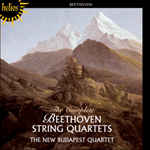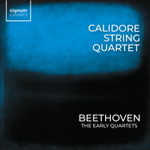
Welcome to Hyperion Records, an independent British classical label devoted to presenting high-quality recordings of music of all styles and from all periods from the twelfth century to the twenty-first.
Hyperion offers both CDs, and downloads in a number of formats. The site is also available in several languages.
Please use the dropdown buttons to set your preferred options, or use the checkbox to accept the defaults.

| Calidore String Quartet» More |
By far the most serious part of this Quartet is the so-called minuet, having the urgency of some of Beethoven's later scherzo movements (which incidentally when they were not humorous he never called 'scherzo'). This dramatically intense 'minuet' has some remarkable chromaticisms, and the Trio, with its constant quick triplets in the first violin, could well have influenced Schubert's quartet textures. The Finale is one of Beethoven's rare excursions into the Hungarian style of which Haydn was fond; it is a simple rondo with a contrasting much broader second theme. At the end the tempo increases and, unlike Haydn in such cases, Beethoven allows the minor key to persist to the end. In this Quartet all the movements are in C.
from notes by Robert Simpson © 1990
Le premier mouvement au style vif transmet un message vigoureux plutôt que la tragédie ou le pathos qui est souvent associé à un ton mineur, et la musique en si bémol du second groupe a un élan d'optimisme dont on ne peut douter. Comme pour confirmer cette impression, il n'y a pas de mouvement lent - à sa place il y a un Andante enjoué en ut majeur, en fait intitulé 'scherzo'; ceci anticipe en quelque sorte le second mouvement de la Première Symphonie, surtout dans son début en fugato.
La partie la plus sérieuse de ce quatuor est de loin le prétendu menuet, qui a l'insistance de certains scherzos ultérieurs de Beethoven (qu'entre parenthèses, il n'intitulait jamais scherzos quand ils n'étaient pas pleins d'humour). Ce 'menuet' spectaculairement intense offre quelques remarquables gammes chromatiques et les triolets incessants et vifs du Trio dans le premier violon, pourraient bien avoir influencé la texture des quatuors de Schubert. Le Finale montre une des rares incursions de Beethoven dans le style hongrois cher à Haydn; c'est un simple rondo, avec un second theme contrastant beaucoup plus ample. A la fin, le tempo s'intensifie et, à la différence de Haydn dans ces cas-là, Beethoven permet au ton mineur de persister jusqu'à la fin. Tous les mouvements de ce quatuor sont en ut.
extrait des notes rédigées par Robert Simpson © 1990
Français: ALBO & Co
Im lebhaften ersten Satz fühlt man eher starke Sachlichkeit als Tragik oder Pathos, hervorgerufen durch die Moll-Tonart. Weiters stellt die Musik der zweite Gruppe in Es-Dur unverkennbare eine optimistische 'Aufhellung' dar. Wie eine Bestätigung wirkt daraufhin das Entfallen eines langsamen Satzes. Stattdessen folgt ein offenherziges C-Dur Andante, hier als Scherzo bezeichnet. Es nimmt in gewisser Weise den zweiten Satz der Ersten Symphonie vorweg, insbesondere durch das Fugato am Beginn.
Bei weitem der ernsthafteste Teil dieses Quartetts ist das sogenannte Menuett, dem die Eindringlich keit einiger späterer Beethoven-Scherzi anhaftet (welche er übrigens niemals 'Scherzo' nannte, wenn sie nicht humoristisch waren). Dieses dramatische und heftige 'Menuett' beinhaltet bemerkenswerte Chromatik und das Trio der ersten Violine mit seinen konstant-schnellen Triolen, könnte leicht Schubert's Quartettstruktur beeinflusst haben. Das Finale ist eine von Beethoven's seltenen Exkursionen in den Ungarischen Stil, in welchen Haydn vernarrt war. Es ist ein einfaches Rondo mit einem kontrastierenden, viel umfassenderen zweiten Thema. Gegen das Ende verschärft sich das Tempo, was atypisch für Haydn wäre. Beethoven behält die Moll-Tonart bis zum Ende bei. Alle Sätze diese Quartetts sind in C.
aus dem Begleittext von Robert Simpson © 1990
Deutsch: Stefan Kapelar
 Beethoven: String Quartets Beethoven: String Quartets‘Fine performances, always intelligent, with many considerable insights … perfect intonation and excellent ensemble and tonal blend, with first-c ... ‘Very fine … I enjoyed these performances because they deliver Beethoven as I want him, free of the biographical sensationalism. Highly recommend ...» More |
 Beethoven: The early quartets Beethoven: The early quartetsThe string quartet was perhaps the most prestigious (and certainly the most lucrative) genre for a composer at the turn of the nineteenth century. Beethoven left nothing to chance with his inaugural Op 18 set, and they were a triumph, here perform ...» More |

